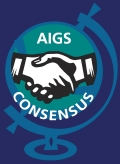advertisement


Highlights from the WGA Consensus Meeting on Intraocular Pressure
May 5, 2007, Fort Lauderdale, FL, USA
The Intraocular Pressure consensus reached a crescendo with the stimulating and provocative meeting held in Fort Lauderdale on May 5, 2007. The resulting consensus points and documents will be published in a forthcoming book that should be available at the time of the World Glaucoma Congress in Singapore. In the meantime, a few highlights of the IOP consensus are provided below.
Measurement of Intraocular Pressure
- Precision and agreement of tonometry devices should be reported
in a standardized format:
- Coefficient of repeatability (for intra-observer variation)
- Mean difference (or difference trend over range) and 95% limits of agreement (for inter-observer and inter-instrument differences)
Comment: Under ideal circumstances for measurement, precision figures reported for GAT are:
- Intraobserver variability: 2.5 mmHg (two readings by the same observer will be within this figure for 95% of the subjects)
- Interobserver variability: ± 4mmHg (95% confidence limits either side of mean difference between observers)
- In clinical practice these figures may be considerably higher
Intra-class correlation coefficients are not clinically useful
- Correction Nomograms that adjust GAT IOP based solely on CCT are neither valid nor useful in individual patients.
Comment: a thick cornea gives rise to a greater probability of an IOP being over-estimated (and a thin cornea of an IOP being under-estimated), but the extent of measurement error in individual patients cannot be ascertained from the CCT alone.
- Measurement of CCT is important in assessing risk for incident glaucoma among ocular hypertensives in the clinical setting, though the association between CCT and glaucoma risk maybe less strong in the population at large.
Intraocular Pressure as a Risk Factor
- There is strong evidence to support higher mean IOP as a significant risk factor for the development of glaucoma.
- There is strong evidence to support higher mean IOP as a significant risk factor for glaucoma progression.
- There is currently insufficient evidence to support 24-hour IOP fluctuation as a risk factor for glaucoma development or progression.
- There is currently insufficient evidence to support IOP variation over periods longer than 24 hours as a risk factor for glaucoma development and progression.
Target Intraocular Pressure
- The determination of a target IOP is based upon consideration of the amount of glaucoma damage, the IOP at which the damage has occurred, the life expectancy of the patient, and other factors including status of the fellow eye and family history of severe glaucoma.
Comment: At present, the target IOP cannot be determined with any certainty in a particular patient.
Comment: There is no validated algorithm for the determination of a target IOP. This does not, however, negate its use in clinical practice.


